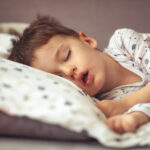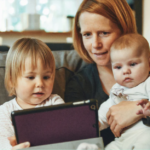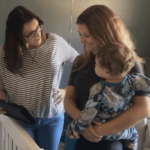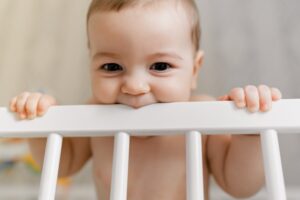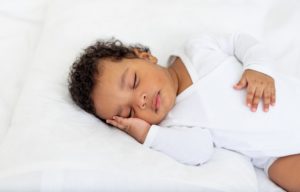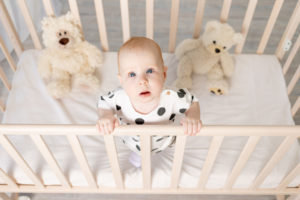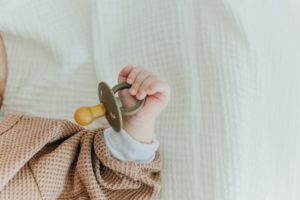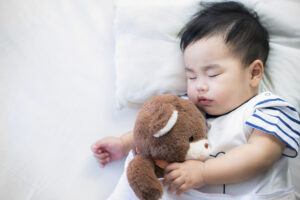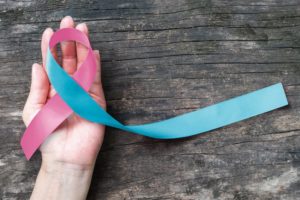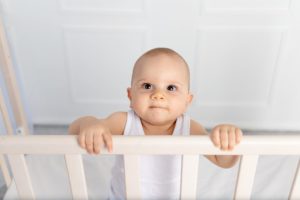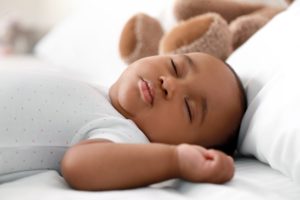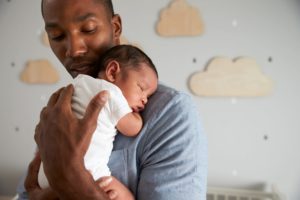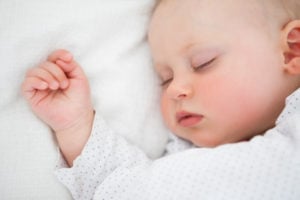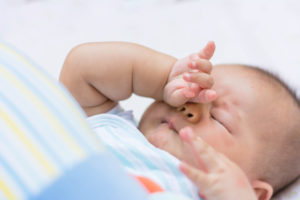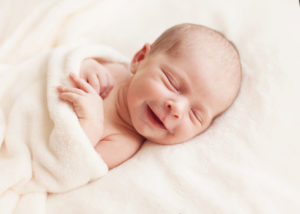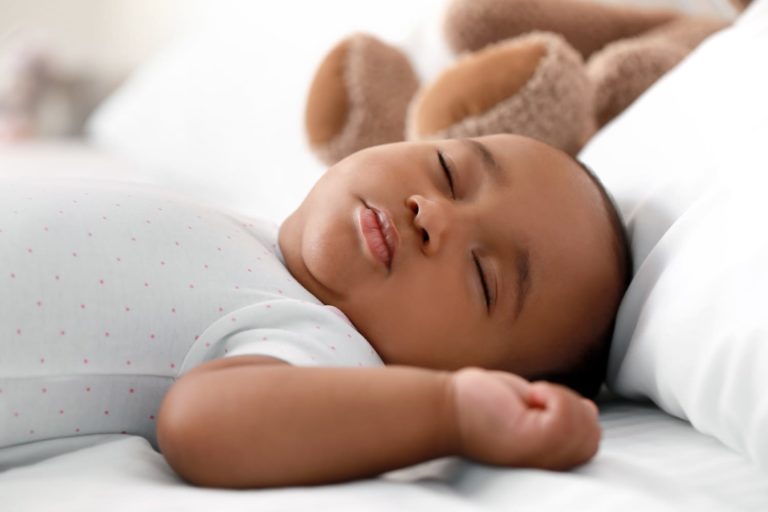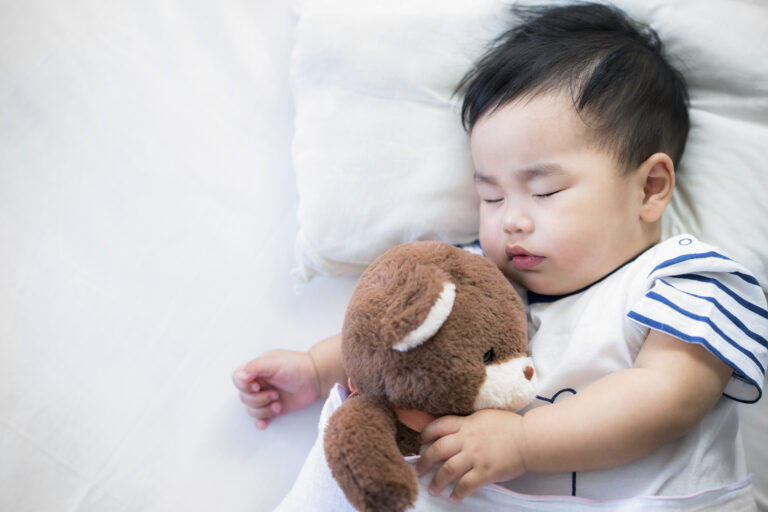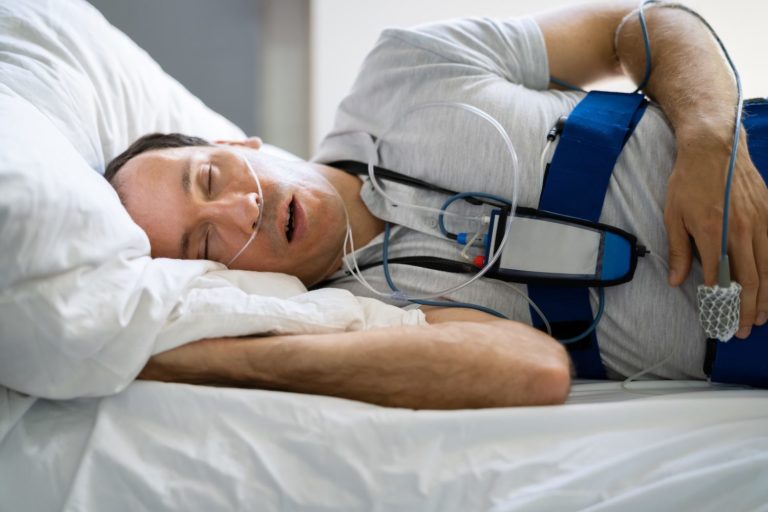When you buy through our links, we may earn a commission. Products or services may be offered by an affiliated entity. Learn more.
Can Babies Sleep in a Swing?
Baby swings are a popular option to entertain or soothe a fussy baby. However, experts do not recommend that babies sleep in a swing. Sleeping in baby swings has been linked to higher risks of injury, flat spots on heads, blocked airways, accidental suffocation, and death. For these reasons, if a baby does fall asleep in a swing, their parent or caregiver should carefully pick them up out of the swing and move them to their crib or bassinet.
We discuss the risks to babies from sleeping in swings, how to safely use a baby swing, and expert recommendations for helping babies sleep safely.
Why Baby Swings Aren’t Safe for Sleep
Baby swings are not designed for sleep. Instead, the purpose of baby swings is to support infant playing. When parents and caregivers use baby swings and other equipment outside of their recommended use, such as for sleeping, they may unintentionally put babies in danger.
An infant sleeping in a baby swing may be at risk for difficulty breathing , injury to the head or neck, or getting tangled in the swing’s equipment.
Risks from Sleeping While Seated
Many baby swings hold babies so that they are sitting upright . While sitting can be fun for play, it is not a safe position for sleep . Young infants have a harder time breathing when they are sitting upright.
Babies have large heads compared to the size of their necks. Newborns less than 4 months old also have difficulty controlling their heads. As a result, young babies often bend their heads forward toward their chests when they are sitting or propped upright. This position can narrow or block their airways, making it difficult for babies to breathe.
Researchers have also found that babies sleeping on tilted surfaces such as swings or inclined sleepers may roll onto their stomachs, particularly if they are not buckled in or if the straps are loose . This is concerning because sleeping on the stomach is the top preventable risk factor for sudden infant death syndrome (SIDS). Babies less than a year old should always be put to sleep on their backs.
Risks to Babies’ Heads and Necks
When sleeping in baby swings, car seats, and bouncers, babies are also at risk for injury because these devices put pressure on the backs of babies’ heads. Babies’ skulls are soft, and too much pressure in one area for a long period of time can cause a flat spot on the head. When babies sleep in swings, pressure on the backs of their heads can cause or worsen flat spots.
Young infants cannot hold their heads facing forward for a long time. For that reason, babies who spend a lot of time in swings may keep their heads turned to one side . This can lead to torticollis, a condition where the neck twists and causes the head to tilt unnaturally.
To prevent flat spots and torticollis, parents and caregivers should limit babies’ time spent in swings. Instead, caregivers can supervise tummy time , when the awake baby is placed on their stomach to stretch and practice motor skills.
Risks from Straps and Cushions
Most baby swings have straps that attach at the baby’s waist and groin and possibly the shoulders. However, occasionally parents or caregivers do not buckle the straps, or they attach the straps too loosely. Loose or unbuckled straps can be dangerous because sleeping babies can become tangled in or even strangled by them. Babies who are not properly strapped in could also fall out of the swings and be injured. To avoid the risk of injury, caregivers should always properly buckle straps on baby swings.
Many baby swings are also padded for comfort. However, cushions and other soft bedding can be hazardous for sleeping babies. Sleeping babies could turn their faces toward the padding and suffocate, particularly if they are not securely buckled. Babies should sleep on firm surfaces without any soft objects such as pillows or toys to avoid this risk.
Help Your Baby Sleep Better With Pediatric Sleep Coaching
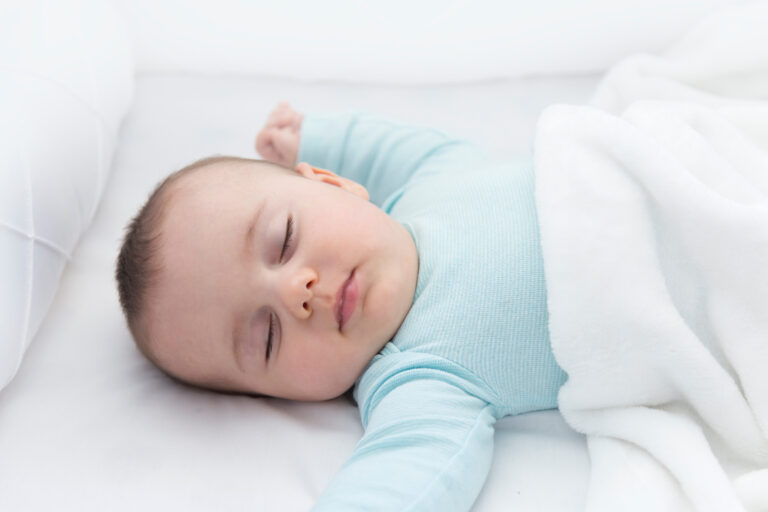
our partner at sleepdoctor.com
Learn More“Life-changing! My anxiety about my son’s sleeping habits were immediately reduced after talking to Sara. She went above and beyond to tailor a schedule to our goals, answer our questions, keep us on track, and check in to encourage us when we just thought we couldn’t do it anymore.”
Rachael B. – Verified Customer
How to Safely Use a Baby Swing
Parents and caregivers should always follow manufacturers’ recommendations for baby swings, including secure buckling, and should always monitor babies while they use swings. Parents and caregivers should also make sure baby swings are stable, in good working condition, and meet current U.S. Consumer Product Safety Commission (CPSC) standards.
New CPSC standards for baby swings took effect in 2013. The standards were updated after the CPSC received over 350 complaints about baby swings, which included 24 injuries and two deaths, in one year.
The new standards require manufacturers to design, test, and add warnings to swings to ensure they are stable, secure, and have seats at safe angles for babies. Baby swings sold after May 2013 must meet the current CPSC standards, but some older swings may not. Parents and caregivers can also check whether their baby swing or other equipment is listed on the CPSC list of recalled products.
Safety Tips for Using a Baby Swing
The American Academy of Pediatrics recommends additional tips to safely use a baby swing .
- Follow weight limits: Check weight limits for the swing and do not put babies in a swing if they weigh more than the limit.
- Keep it flat: Tilt the swing back to its flattest position for babies younger than 4 months.
- Secure with straps: Use shoulder straps on babies when they sit up in a swing.
- Check attachments: Keep any mobile toys securely attached and out of babies’ reach .
- Use on flat surfaces: Never place baby swings in cribs, on mattresses, or on other raised surfaces.

How Long Can a Baby Sleep in a Swing?
Due to the risk of injury, experts do not recommend babies sleep in a swing. If a baby falls asleep in a swing, then the parent or caregiver should take the baby out of the swing and move them to a crib or bassinet.
While experts do not have a maximum recommended duration babies can spend in a swing, the American Academy of Pediatrics and the American Academy of Family Physicians agree that babies should not spend a long time in swings or similar equipment. Babies need a variety of activities, including tummy time, cuddles, and play, for healthy physical, cognitive, and social development.
Additionally, babies who regularly sleep in a swing may eventually have difficulty sleeping through the night or learning to sleep in a crib. When children need a particular routine, setting, or object in order to fall asleep, then they may wake up during the night and be unable to fall back to sleep without their preferred object or routine.
Parents or caregivers of babies who can only sleep in a swing should try putting them to bed in a crib or bassinet when they are sleepy but still awake. If a baby continues to have difficulties falling asleep without a swing, then their parents or caregivers should talk to a doctor about whether sleep training is appropriate.

Still have questions? Ask our community!
Join our Sleep Care Community — a trusted hub of sleep health professionals, product specialists, and people just like you. Whether you need expert sleep advice for your insomnia or you’re searching for the perfect mattress, we’ve got you covered. Get personalized guidance from the experts who know sleep best.
References
13 Sources
-
Corwin, M. J. (2022, July 26). Patient education: Sudden infant death syndrome (SIDS) (Beyond the basics). In S. M. Misra (Ed.). UpToDate., Retrieved November 14, 2022, from
https://www.uptodate.com/contents/sudden-infant-death-syndrome-sids-beyond-the-basics -
U.S. Consumer Product Safety Commission. (n.d.) Infant swings., Retrieved November 14, 2022, from
https://www.cpsc.gov/FAQ/Infant-Swings -
Moon, R. Y., Carlin, R. F., Hand, I., & Task Force on Sudden Infant Death Syndrome and the Committee on Fetus and Newborn (2022). Evidence base for 2022 updated recommendations for a safe infant sleeping environment to reduce the risk of sleep-related infant deaths. Pediatrics, 150(1), e2022057991.
https://pubmed.ncbi.nlm.nih.gov/35921639/ -
Tonkin, S. L., Vogel, S. A., Bennet, L., & Gunn, A. J. (2006). Apparently life threatening events in infant car safety seats. BMJ (Clinical Research Ed.), 333(7580), 1205–1206.
https://pubmed.ncbi.nlm.nih.gov/17158387/ -
Batra, E. K., Midgett, J. D., & Moon, R. Y. (2015). Hazards associated with sitting and carrying devices for children two years and younger. The Journal of Pediatrics, 167(1), 183–187.
https://pubmed.ncbi.nlm.nih.gov/25917769/ -
Adams, S. M., Ward, C. E., & Garcia, K. L. (2015). Sudden infant death syndrome. American Family Physician, 91(11), 778–783.
https://pubmed.ncbi.nlm.nih.gov/26034855/ -
Biggs W. S. (2003). Diagnosis and management of positional head deformity. American Family Physician, 67(9), 1953–1956.
https://pubmed.ncbi.nlm.nih.gov/12751657/ -
Eunice Kennedy Shriver National Institute of Child Health and Human Development. (n.d.). Babies need tummy time!, Retrieved November 15, 2022, from
https://safetosleep.nichd.nih.gov/safesleepbasics/tummytime -
U.S. Consumer Product Safety Commission. (2012, November 13). CPSC approves new federal safety standard for infant swings., Retrieved November 16, 2022, from
https://www.cpsc.gov/Newsroom/News-Releases/2013/CPSC-Approves-New-Federal-Safety-Standard-for-Infant-Swings -
Korioth, T. (2013, January 1). Safe and sound: Tips for using infant swings. AAP News., Retrieved November 14, 2022, from
https://publications.aap.org/aapnews/article/34/1/25/24388/Safe-and-sound-tips-for-using-infant-swings -
American Academy of Pediatrics. (2009, November 12). Tips for buying baby furniture & baby equipment., Retrieved November 16, 2022, from
https://www.healthychildren.org/English/ages-stages/prenatal/decisions-to-make/Pages/Buying-Furniture-and-Baby-Equipment.aspx -
Moon, R. Y., Carlin, R. F., Hand, I., & Task Force on Sudden Infant Death Syndrome and the Committee on Fetus and Newborn (2022). Sleep-related infant deaths: Updated 2022 recommendations for reducing infant deaths in the sleep environment. Pediatrics, 150(1), e2022057990.
https://pubmed.ncbi.nlm.nih.gov/35726558/ -
Owens, J. A. (2020, August 18). Behavioral sleep problems in children. In R. D. Chervin (Ed.). UpToDate., Retrieved November 15, 2022, from
https://www.uptodate.com/contents/behavioral-sleep-problems-in-children


